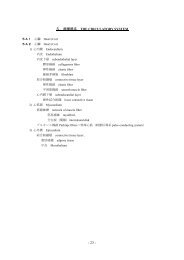Program / Abstract Book - KMU WWW3 Server for Education ...
Program / Abstract Book - KMU WWW3 Server for Education ...
Program / Abstract Book - KMU WWW3 Server for Education ...
Create successful ePaper yourself
Turn your PDF publications into a flip-book with our unique Google optimized e-Paper software.
No. 16 (PC 16)<br />
Temporal changes in estimated glomerular filtration rate (delta eGFR) may be a<br />
predictor of progression to coronary heart disease<br />
So-Young Kim, Tae-Dong Jeong, Woochang Lee, Sail Chun, Won-Ki Min*<br />
Department of Laboratory Medicine, Asan Medical Center and University of Ulsan College of Medicine,<br />
Seoul, Korea<br />
Background: Chronic kidney disease and cardiovascular disease are major public health problems<br />
worldwide and often share the same pathophysiological mechanisms. Indeed, the prevalence of<br />
traditional cardiovascular risk factors can be higher in those with impaired kidney function, and most<br />
patients with a lower estimated glomerular filtration rate (eGFR) die of cardiovascular causes and not<br />
due to progression to end stage renal disease. However, the effect of reduced eGFR on coronary heart<br />
disease has not been well delineated among Korean population. Here, we reviewed temporal changes in<br />
eGFR (delta eGFR, ΔeGFR) of the healthy Korean population, and then, carried out a study to<br />
investigate the link between a ΔeGFR and the risk of coronary heart disease.<br />
Methods: We reviewed data of 7676 healthy outpatients selected from a population of - 10,000<br />
individuals referred to the health promotion center of the ASAN medical center between January 2010<br />
and December 2010. At the time of the first evaluation, data of patients` age, sex, blood pressure,<br />
creatinine, total cholesterol, LDL, HDL and triglycerides as well as history of smoking, hypertension or<br />
familial coronary heart disease were collected by chart review. The % risk of coronary heart disease<br />
were calculated by Framingham score (Score:www.nhlbi.nih.gov/guidelines/cholesterol). We classified<br />
ΔeGFR % into 4 groups according to Gaussian distribution, ±2 standard deviation (SD); below -2SD,<br />
-2SD to mean, mean to +2SD, over +2SD (mean=1.559, SD=9.5837).<br />
Results: Among the enrolled patients, 5.9% (456 patients) were over 15 of the Framingham score, and<br />
this is equivalent of coronary heart disease risk over 20% which means they have high risk <strong>for</strong><br />
occurrence of coronary heart disease in ten yrs. A group of over +2SD (ΔeGFR > 19.17%) had odds<br />
ratio of 3.656, and it was related to incident % risk of coronary heart disease rather than other ΔeGFR<br />
groups.<br />
Conclusions: A decline of eGFR > 19.17% was independently related to incident % risk of coronary<br />
heart disease. ΔeGFR could be a possible indicator of progression to the coronary heart disease in<br />
general population. There<strong>for</strong>e, this parameter may be potentially used <strong>for</strong> screening subjects with higher<br />
risk of coronary heart disease.<br />
Keywords: estimated glomerular filtration rate (eGFR), delta eGFR (ΔeGFR), coronary heart disease,<br />
chronic kidney disease<br />
- 69 -



